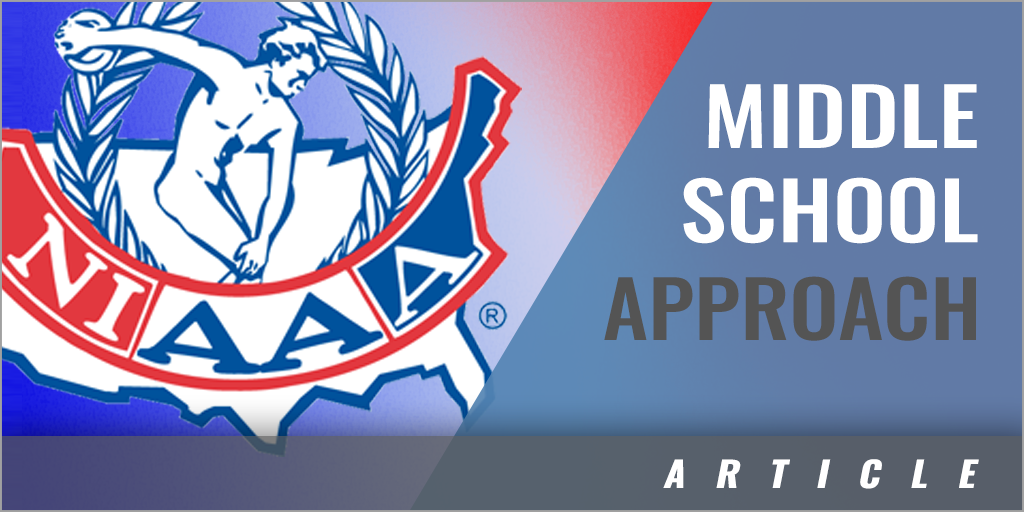|
By: Gary Stevens, Athletic Administrator - Thornton Academy (Saco, Maine) Introduction As the American middle school movement came into prominence in the late 1970s and 1980s, education-based athletics struggled to keep pace with the philosophy that was transforming school culture, curriculum, and instruction. In the first two parts of this three-part series on middle level athletics, I examined how schools can reimagine their athletic programs in a manner that reinforces the philosophy and organization that underlies that of the classroom. A philosophical move from treating those programs as "miniature versions" of those in the upper grades to an approach that manages athletics as one component in the holistic development of the child is part of that paradigm shift. Every aspect of the program (sport offerings, philosophy of play, an emphasis on values-based education) must be geared to support the physical, social, and emotional development of each child who participates. The most significant individual in delivering the curriculum of a middle school athletic program is the coach. He or she must have "situational fluency" when making decisions about practice organization, playing time, and game strategy. In an age when the presence of a teacher/coach on the sideline is on the decline, the middle school coach may require an investment of time and resources to educate him or her about the teaching and motivational strategies that are appropriate for children of this age. The middle school coach teaches, not criticizes, and is an important role model whose behaviors and actions can impact those in his or her care in a variety of ways. In this final installment of the series, we will explore how the athletic administrator empowers the middle school coach while putting this philosophy into action. How practices are organized and executed daily forms the blueprint for carrying out that plan. The ability of the middle school coach to design and implement a practice plan that focuses on fundamentals while providing a fun environment remains the crux of an effort to install this philosophy. Similarly, working in concert with other schools to develop conference protocols for conducting activities creates a collective approach that supports that process. Each of these steps may require significant change from the status quo and may be met with skepticism and resistance. They require continuous work, attention, and education as the players involved in decision-making change. It is important to educate all stakeholders - coaches, student-athletes, and parents in the minutiae of the process and the philosophy behind those decisions that are made. Inside the Middle School Athletic Practice Athletic coaches generally operate within a personal philosophy that prioritizes one of the following three objectives:
Certainly, there is a place for all three components within an individual coach's plan of action. Generally speaking, the scoreboard is turned on during athletic competitions, and each team or individual participating in the event strives for a successful outcome. Players cannot perform well unless they have a grasp of the fundamentals of their respective sports. At the same time, one of the major reasons that student-athletes compete is that they enjoy the camaraderie of their teammates and the joy that they experience when achieving success. Identifying the philosophy that serves as the "rudder" for the middle school program is an important starting point for any coach. The middle school years represent a period of transition between a time of childhood (the elementary phase) and the time that they are considered to be young adults. Athletically speaking, whereas youth and recreational programs exist to foster a love of the game by focusing less on winning and more on creating a fun atmosphere, the primary focus middle school athletics should be to help participants hone their skills. It is the period of their development where students are exposed to some strategic points that may benefit them at the secondary school level, but not at the expense of fundamentals. Middle school athletic practice sessions should typically be one to one and one-half hours in duration. Drill segments should be approximately five to ten minutes in length, each with a frequent shift between activities. Coaches should consider using the scoreboard or other timing device to ensure that not too much time is spent on any one activity. Whenever possible, activities should be organized to minimize the amount of time that participants remain standing in lines; providing frequent repetitions to practice fundamentals of the sport should be the aim of any given session. Sport fundamentals should be taught in a progression that allows participants to be successful in foundational components before moving on to higher-level skills. Unlike high school athletic activities that represent a major commitment of time and effort, participation in athletics represents just one part of a middle school child's experience. Middle school programs typically run five days a week, and whenever possible, practices and contests should be scheduled for the hours immediately following the last bell. Practices and contests are rarely, if ever, held on weekends to allow students an opportunity to spend additional time with their families or to pursue other interests. Schools employing a middle school philosophy are hesitant to schedule activities during holidays or vacation schedules. "Game On!": A Philosophy of Scheduling and Conducting Middle School Athletic Contests One of the important draws for students participating in any athletic program is the opportunity to compete. The middle school athletic administrator is charged with the important task of building a schedule that provides this important outlet for the students while maintaining a philosophy that is consistent with this level of education. Middle school athletics personnel should consider the following when developing the game schedule:
Middle school athletics leaders also strive to minimize scheduling conflicts with other school activities, such as concerts, dramatic performances, and exhibitions. Athletics is, and should be, only one component of the child's overall middle school experience. The well-rounded student is given an opportunity to explore other aspects of his personality and talents; facing a choice between two immovable objects (i.e. entrenched adults) is not fair to a child of this age group. A Collective Approach A school's middle school athletic philosophy works best when there are other districts that operate under a similar philosophy. Many middle school conferences or leagues throughout the United States are working collectively and intentionally to deliver a true "middle school approach." As a result, these schools have reimagined middle school athletic programming and have woven an age-appropriate philosophy into their areas of the country. Among the ideas implemented in middle school conferences are:
It must always be remembered that many middle school coaches and parents may be products of a generation that employed a quasi-high school approach to conducting middle school competition. The athletic administrators of a given middle school league will need to find avenues to continuously communicate to and educate these stakeholders. End Game Implementing a true middle school philosophy into an athletic program is not an easy task. It takes a vision, time, patience, and an understanding of how athletics fits into the school's overall mission. Most athletic directors cannot do it alone; they require the support and understanding of their communities, coaches, and the students whom they serve. They must work in concert with their school's administration and faculty to ensure that the athletic programs complement that of the educational program. For most people in the profession, "finding the middle ground" is a journey that is fraught with obstacles and challenges - from entrenched coaches who are set in their ways, from passionate parents whose philosophies may not be consistent with that of the school, and with conference colleagues who may resist or resent change. However, reinventing an athletics program so that it is age-appropriate and philosophically-sound makes a compelling case for that change. In an era where many students are opting to drop out of participation in high school sports because they no longer love the game or see themselves as being successful, finding a way to fan the flames and stoke their passion for sport should be at the top of every middle school athletic director's list of priorities. The process begins with understanding the psychology and development of the children he or she serves. |







